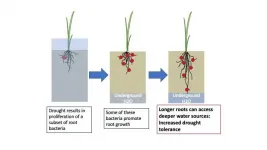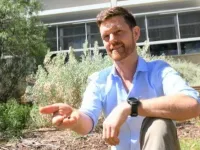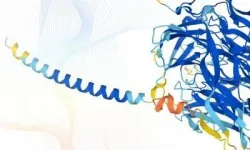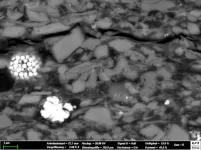Untwisting DNA reveals new force that shapes genomes
Transcription generates a force that moves across DNA strands like ripples through water
2021-07-22
(Press-News.org) Advances in microscopy have enabled researchers to picture loops of DNA strands for the first time. The images reveal how the human genome organises itself in three-dimensional space at much higher resolution than previously possible.
The findings, published in a new study in the journal Molecular Cell, also reveal that the process of DNA being copied into RNA - transcription - indirectly shapes the architecture of the genome. An international team led by Pia Cosma at the Centre for Genomic Regulation (CRG) in Barcelona and Melike Lakadamyali at the Perelman School of Medicine at the University of Pennsylvania in the United States found that transcription generates a force that moves across DNA strands like ripples through water.
Known as supercoiling, the force causes structural proteins known as cohesins to 'surf' across DNA strands, changing the scaffold's architecture and morphing the overall shape of the genome. While it is known that genome organization regulates gene transcription, it is the first-time researchers have found transcription to impact genome organization the other way round through supercoiling.
According to the researchers, the discovery of this new force may have future implications for the understanding of genetic diseases such as Cornelia de Lange syndrome, which is caused by mutations in genes encoding for cohesin or cohesin regulators. The findings may also be relevant for developmental disorders linked to how chromatin folds, as well as opening new avenues of research in genome fragility and cancer development.
The researchers studied the biological mechanisms that enable two metres of DNA to be squeezed into a tight space in each human cell. In this condensed state, the DNA, also known as chromatin, contains many loops that bring together different regions of the genome that would normally be far apart. The resulting physical proximity is important for transcribing DNA into RNA which then makes proteins, making chromatin looping a fundamental biological mechanism for human health and disease.
According to Vicky Neguembor, Staff Scientist at the CRG and first author of the paper, "Chromatin looping is what allows individual cells to switch different information on and off, which is why for example a neuron or a muscle cell with the same genomic information can still behave so differently. Loops are also one of the ways the genome gets compacted to fit into the nucleus."
"What we have found is important because it shows the biological process of transcription plays an additional role beyond its fundamental task of creating RNA that eventually turn into proteins. Transcription indirectly compacts the genome in an efficient manner and helps different regions of the genome talk to each other."
Previous techniques used to study this process could predict where loops were located but not their actual shape or how they look like within the cells. To improve image resolution, the researchers used a special type of microscopy that use high-power lasers under specific chemical conditions to track the blinking of fluorescent molecules. The technique provides ten times higher resolution than conventional microscopy, and combined with advanced imaging analysis techniques the researchers were able to identify chromatin loops, and the cohesins that hold the structure together like paper clips, within intact cells.
INFORMATION:
ELSE PRESS RELEASES FROM THIS DATE:
2021-07-22
Manipulating RNA can allow plants to yield dramatically more crops, as well as increasing drought tolerance, announced a group of scientists from the University of Chicago, Peking University and Guizhou University.
In initial tests, adding a gene encoding for a protein called FTO to both rice and potato plants increased their yield by 50% in field tests. The plants grew significantly larger, produced longer root systems and were better able to tolerate drought stress. Analysis also showed that the plants had increased their rate of photosynthesis.
"The change really is dramatic," said University of Chicago Prof. Chuan He, who together with Prof. Guifang Jia at Peking University, led ...
2021-07-22
A new study showed that a wearable computer vision device can reduce collisions for both people who are blind or those who are visually impaired and using a long cane and/or guide dog by 37 percent, compared to using other mobility aids alone.
People who have visual impairments are at a significantly higher risk for collisions and falls. Commonly used mobility aids like long canes and guide dogs can offer benefits, but come with limitations in effectiveness and costs, respectively. While some electronic devices are marketed direct-to-consumer claiming to warn wearers of surrounding objects, there has been little evidence of their effectiveness in actual daily mobility settings. This is one of the first randomized-controlled trials to look at the potential benefit of the ...
2021-07-22
What The Study Did: This study included 647 patients with untreated nonmetastatic prostate cancer (269 patients during the pandemic and 378 from before the pandemic). During the initial COVID-19 lockdown, only 1% of Black men underwent prostatectomy, while 26% of white patients did. Prior to the pandemic, there was no difference in the rate of prostatectomy between the two races (18% of Black men and 19% of white men). The lessons from this study suggest systemic inequities within health care and are likely applicable across medical specialties. Public health efforts are needed to fully recognize the unintended consequence of diversion of cancer resources to the COVID-19 pandemic to develop balanced mitigation strategies as viral rates continue to fluctuate.
Authors: ...
2021-07-22
Drought can have a lasting impact on the community of microbes that live in and around roots of rice plants, a team led by UC Davis researchers has found. Root-associated microbes help plants take up nutrients from the soil, so the finding could help in understanding how rice responds to dry spells and how it can be made more resilient to drought. The work is published July 22 in Nature Plants.
The root microbiome of irrigated rice plants goes through a sequence of changes as the plants grow and stabilizes when they flower. The sequence of changes in the root ...
2021-07-22
Restoration of degraded drylands is urgently needed to mitigate climate change, reverse desertification and secure livelihoods for the two billion people who live there, experts warn in a major new paper in Nature Ecology & Evolution.
Scientists leading the Global Arid Zone Project examined restoration seeding outcomes at 174 sites on six continents, encompassing 594,065 observations of 671 plant species - with the lessons learned important to meeting ambitious future restoration targets.
Flinders University Dr Martin Breed, one of three Australian researchers who helped coordinate ...
2021-07-22
LONDON, 22 July 2021 - DeepMind today announced its partnership with the European Molecular Biology Laboratory (EMBL), Europe's flagship laboratory for the life sciences, to make the most complete and accurate database yet of predicted protein structure models for the human proteome. This will cover all ~20,000 proteins expressed by the human genome, and the data will be freely and openly available to the scientific community. The database and artificial intelligence system provide structural biologists with powerful new tools for examining a protein's three-dimensional structure, and offer a treasure trove of data that could unlock future advances and herald a new era for AI-enabled biology.
AlphaFold's recognition in December 2020 by the ...
2021-07-22
Newly-hatched pterosaurs may have been able to fly but their flying abilities may have been different from adult pterosaurs, according to a new study.
Pterosaurs were a group of flying reptiles that lived during the Triassic, Jurassic and Cretaceous Periods (228 to 66 million years ago). Due to the rarity of fossilised pterosaur eggs and embryos, and difficulties distinguishing between hatchlings and small adults, it has been unclear whether newly-hatched pterosaurs were able to fly.
Researchers from the Universities of Portsmouth and Bristol, along with palaeontologist Darren Naish, found that hatchling humerus bones were stronger than those of many adult pterosaurs, indicating ...
2021-07-22
The Alum Shale of Northern Europe not only has an eventful history of formation, connected with the microcontinent Baltica, it also holds great potential as an object of investigation for future research questions. Geologists use the rock to reconstruct processes of oil and gas formation, and even possible traces of past life on Mars can be identified with its help. Researchers at the German Research Centre for Geosciences Potsdam GFZ, together with colleagues from Canada, China, Switzerland and Denmark, have summarised the state of knowledge about the multi-layered rock. Their article was published in July in the journal Earth-Science Reviews.
The Microcontinent Baltica
"This rock tells a story," says Hans-Martin Schulz when he talks about the Northern European Alum Shale. It is ...
2021-07-22
Astronomers using two of the world's most powerful radio telescopes have made a detailed and sensitive survey of a large segment of our home galaxy -- the Milky Way -- detecting previously unseen tracers of massive star formation, a process that dominates galactic ecosystems. The scientists combined the capabilities of the National Science Foundation's Karl G. Jansky Very Large Array (VLA) and the 100-meter Effelsberg Telescope in Germany to produce high-quality data that will serve researchers for years to come.
Stars with more than about ten times the mass of our Sun are important components of the Galaxy ...
2021-07-22
Around 470 million years ago, plants began to conquer the terrestrial surfaces. The first examples had a small axis terminated by a structure capable of forming spores, almost like current mosses. The appearance of plant organs mediated the explosive radiation of land plants, which shaped the surface of our planet and allowed the establishment of terrestrial animal life.
However, evolving such a diversity of organs, such as roots, leaves, or immobile gametes, requires coordinated genetic changes: rise of new genes, repurpose of genetic material, and development of new regulatory programs. In a study published in Nature Plants, a consortium ...
LAST 30 PRESS RELEASES:
[Press-News.org] Untwisting DNA reveals new force that shapes genomes
Transcription generates a force that moves across DNA strands like ripples through water






